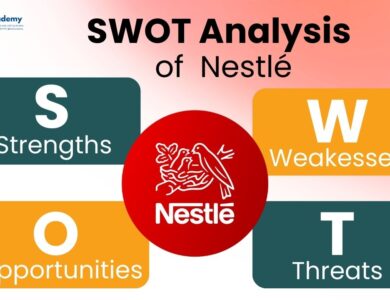SWOT Analysis of Cadbury: Strengths, Weaknesses, Opportunities & Threats
Explore a comprehensive SWOT analysis of Cadbury, highlighting its strengths, weaknesses, opportunities, and threats in the competitive confectionery market.

When someone says chocolate, chances are your mind instantly jumps to Cadbury—that unmistakable purple wrapper and the comforting taste of Dairy Milk that brings back childhood memories. But beyond the sweetness lies a strategic powerhouse that’s been dominating the global confectionery market for decades.
Founded in the early 1800s and now owned by Mondelez International, Cadbury isn’t just a brand—it’s an emotion, especially in countries like India and the UK. But what exactly makes Cadbury so successful? And where does it struggle?
In this blog, we’ll unwrap the SWOT analysis of Cadbury—a deep dive into its Strengths, Weaknesses, Opportunities, and Threats—to understand what keeps this brand ahead of the curve and where its future lies.
Let’s get started!
Learn AI & Digital Marketing,
Pay Fees After Placement
- ✅ Minimal Admission Fees
- ✅ No Loan or Income Sharing Agreement
- ✅ 100% Placement Support
- ✅ ISO & Govt Registered Certificate
- ✅ Practical 3+1 Months Duration
Get a free counseling call. We’ll guide you through learning, certification, and job placement.
Request a Free Call Back
Takes less than a minute.
Company Overview of Cadbury
Cadbury’s journey started all the way back in 1824, when John Cadbury opened a small shop in Birmingham, England, selling cocoa and drinking chocolate. What began as a humble venture turned into one of the most loved chocolate brands in the world.
Today, Cadbury is a proud part of Mondelez International, and it operates in more than 50 countries, with major markets including the United Kingdom, India, Australia, and South Africa. In fact, in countries like India, Cadbury enjoys over 60% market share in the chocolate segment—yes, that’s how dominant it is!
From classic bars like Dairy Milk and Perk to festive favorites like Celebrations, Cadbury has a product for every occasion, mood, and craving. But it’s not just about taste—the brand has consistently connected with emotions, festivals, and even everyday moments of joy.
Now that we’ve unwrapped its story, let’s dive into what makes Cadbury truly strong.
Strengths of Cadbury
When it comes to strengths, Cadbury plays the game like a pro. It’s not just the taste that makes it stand out—it’s the entire experience, from the packaging to the emotional connection people feel when they unwrap a bar.
1. Unbeatable Brand Recognition
Cadbury isn’t just well-known—it’s iconic. The purple wrapper, the Dairy Milk font, the heartwarming ads—all of it contributes to brand loyalty that many companies can only dream of. In countries like India and the UK, Cadbury is practically synonymous with chocolate.
2. Extensive Product Portfolio
Cadbury has mastered the art of variety. Whether it’s Dairy Milk for everyday joy, Perk and 5 Star for a quick snack, or Silk for premium indulgence, Cadbury has something for every price point and occasion. Their festive offerings like Celebrations also dominate gift-giving during festivals.
3. Widespread Distribution Network
From big supermarkets in London to local departmental stores in small Indian towns, Cadbury is everywhere. Its robust supply chain and distribution reach make sure no craving goes unsatisfied.
4. Memorable Marketing Campaigns
Cadbury’s ads have a magic of their own. Campaigns like “Kuch Meetha Ho Jaaye” in India built not just awareness but emotional bonds. Whether it’s a wedding, exam result, or festival—Cadbury has positioned itself as the perfect sweet companion.
5. Backed by Mondelez’s Global Power
As part of Mondelez International, Cadbury gets access to global R&D, innovations, and supply chain efficiencies that give it a competitive edge in both pricing and production.
With so many strengths in its basket, it’s no surprise that Cadbury has remained a market leader for so long. But like every brand, it also has a few cracks in the shell.
Weaknesses of Cadbury
Even giants have their soft spots—and Cadbury is no exception. Despite its emotional connection and wide reach, the brand faces some challenges that can’t be ignored.
1. Overdependence on Chocolate
Cadbury is primarily a chocolate-first brand. Unlike competitors like Nestlé or ITC, which have diversified into snacks, beverages, and instant foods, Cadbury still leans heavily on chocolates. This makes it vulnerable to shifts in consumer tastes, especially when people start cutting back on sugar.
2. Health Concerns & High Sugar Content
With increasing awareness around healthy eating, Cadbury’s sugar-loaded products often come under the scanner. For health-conscious consumers, Cadbury isn’t always the first choice anymore—and that’s a growing concern in today’s market.
3. Past Controversies & Quality Issues
Remember the infamous worm controversy in India (2003)? It severely dented Cadbury’s trust for a while. Though the brand bounced back with aggressive damage control and revamped packaging, such incidents reveal a fragility in quality assurance and perception.
4. Pricing Sensitivity in Developing Markets
In price-sensitive markets like India or Nigeria, even small price hikes can shift customers to cheaper local alternatives. Maintaining affordability while ensuring quality is always a tough balancing act.
While these weaknesses aren’t deal-breakers, they are definitely areas Cadbury needs to stay cautious about.
Read more SWOT articles:
- SWOT Analysis of Britannia: How the Biscuit Giant Stays Ahead in India’s FMCG Market
- SWOT Analysis of Coca-Cola: Inside the Strategy of the Global Beverage Leader
Opportunities for Cadbury
Despite being a well-established brand, Cadbury still has a world of opportunities ahead—especially in evolving markets and changing consumer preferences. Here’s where the brand can grow even stronger:
1. Expansion in Emerging Markets
As disposable incomes rise in countries like India, Indonesia, and parts of Africa, more consumers are willing to spend on premium and indulgent treats. Cadbury, with its emotional appeal and brand loyalty, is perfectly positioned to ride this wave and deepen its market penetration.
2. Health-Conscious Product Development
Consumers today are more mindful of their dietary choices. While Cadbury has long offered dark chocolate options since the launch of Bournville in 1908, the growing demand for healthier alternatives opens doors to expand this segment further.
Introducing more low-sugar, no-added-sugar, or plant-based products can help Cadbury cater to health-conscious audiences while maintaining its legacy of indulgence.
3. Growth in Online & D2C Channels
Cadbury can further enhance its direct-to-consumer (D2C) strategy by expanding its online store offerings, launching subscription-based chocolate boxes, and investing in digital-first campaigns.
Deeper integration with e-commerce platforms and personalized online experiences can improve customer loyalty and drive sales beyond retail shelves.
4. Innovation in Festive & Gifting Segments
Cadbury has already done well with its “Celebrations” and “Silk” range during festivals and special occasions.
The brand can stand out by offering hyper-personalized gift packs, AI-powered gift recommendation tools, and limited-edition collectible packaging—catering to a generation that values both convenience and emotional connection in their purchases.
5. Sustainability and Ethical Sourcing
Modern consumers care about how their food is made. By doubling down on its Cocoa Life program and clearly communicating its sustainable practices, Cadbury can strengthen its brand narrative, especially among eco-conscious buyers.
If Cadbury plays its cards right, these opportunities can not only boost its revenue but also solidify its position as a forward-thinking brand. But to stay on top, it must also stay alert to external threats.
Threats to Cadbury
Even the most loved brands aren’t immune to external challenges. As Cadbury continues to grow, it must navigate a few serious threats that could impact its market share, reputation, or profitability.
1. Intense Market Competition
Cadbury operates in a fiercely competitive industry. It faces constant pressure from global giants like Nestlé, Hershey’s, and Ferrero, as well as rising local brands offering affordable alternatives. In markets like India, even regional players are giving stiff competition by offering similar products at lower prices.
2. Rising Health Awareness
As more consumers shift toward healthy eating, sugary products like chocolate face increasing scrutiny. Cadbury’s core offerings, which are high in sugar, may fall out of favor unless they evolve. This health-driven trend isn’t just a passing phase—it’s reshaping the entire food industry.
3. Raw Material Price Fluctuations
Cocoa, sugar, and milk are all subject to global supply chain issues and price volatility. A sudden rise in input costs can eat into Cadbury’s margins, especially in price-sensitive regions where it’s hard to pass on these costs to consumers.
4. Regulatory Pressures
Governments worldwide are tightening regulations on food and beverages, especially those high in sugar. From sugar taxes to strict advertising rules targeting children, such policies could significantly impact Cadbury’s marketing freedom and product pricing.
5. Supply Chain Disruptions
Events like the COVID-19 pandemic, geopolitical conflicts, or shipping delays can disrupt the smooth delivery of raw materials and finished products. For a brand like Cadbury that relies heavily on scale and consistency, such interruptions can lead to lost sales and damaged trust.
While these threats don’t signal disaster, they do demand constant innovation, agility, and adaptability—something Cadbury has historically done well. But how does it compare with competitors in the same space?
Competitor Analysis Table
To truly understand Cadbury’s strategic position, it helps to compare it with other key players in the global and regional confectionery space. Each brand brings something unique to the table—whether it’s premium appeal, pricing strategy, or diversification.
Here’s a quick side-by-side snapshot:
| Brand | Headquarters | Key Strengths | Key Weaknesses |
|---|---|---|---|
| Cadbury | United Kingdom | Strong brand recall, emotional connect, diverse portfolio | High sugar content, limited product diversification |
| Nestlé | Switzerland | Broad food portfolio, global trust, innovation leadership | Less emotional branding in chocolate segment |
| Hershey’s | United States | Strong presence in North America, premium branding | Weak penetration in Asia and developing countries |
| Ferrero Rocher | Italy | Premium packaging, gifting-focused, strong seasonal sales | High pricing limits mass-market appeal |
| Amul | India | Affordable pricing, wide distribution, strong dairy backing | Limited premium product perception outside India |
Key Takeaway:
Cadbury holds a unique place in the market—it blends affordability with emotional storytelling like no other. While it doesn’t lead in every category (like health or premium), it dominates in relatability and everyday indulgence.
Conclusion
Cadbury is more than just a chocolate brand—it’s a symbol of comfort, celebration, and nostalgia for millions around the world. From its humble beginnings in 1824 to becoming a household name across continents, its journey has been nothing short of iconic.
Through this SWOT analysis, we’ve seen how Cadbury’s strong brand identity, emotional marketing, and extensive product range keep it ahead of the curve. At the same time, we’ve acknowledged real concerns like health trends, competition, and regulatory challenges that it must actively address.
What makes Cadbury truly special is its ability to evolve while staying connected to its roots. By exploring new product categories, embracing health-conscious trends, and continuing to innovate during festive seasons, Cadbury has the potential to delight both loyal fans and new-age consumers alike.
In the ever-changing world of FMCG, brands that blend emotional value with adaptability are the ones that thrive—and Cadbury is a shining example of just that.
Frequently Asked Questions (FAQs)
1. Is Cadbury an Indian company?
No, Cadbury originated in the United Kingdom in 1824. However, it has a massive presence in India and is owned by Mondelez International, a U.S.-based multinational. In India, Cadbury is often seen as a “local” brand due to its deep cultural connect and marketing approach.
2. What is the biggest strength of Cadbury?
Cadbury’s biggest strength lies in its brand equity and emotional connection with consumers. Its wide product range, consistent quality, and iconic advertising campaigns have helped it become a household name across generations.
3. Is Cadbury planning to launch healthier options?
Yes, Cadbury is focusing on expanding its plant-based chocolate offerings, catering to growing demand for dairy-free options. Additionally, the brand is exploring recipes with more nuts and natural ingredients to create snacks that feel both indulgent and nourishing.
4. Who are Cadbury’s main competitors?
Cadbury competes with global brands like Nestlé, Hershey’s, Ferrero Rocher, and regional players like Amul (India). Each of these brands brings unique strengths in pricing, innovation, or premium positioning.
5. Is Cadbury chocolate safe to eat?
Yes, Cadbury follows strict quality control standards. Past incidents, like the 2003 worm controversy in India, led to stronger packaging and safety protocols. Today, Cadbury maintains high hygiene and safety benchmarks across all markets.





